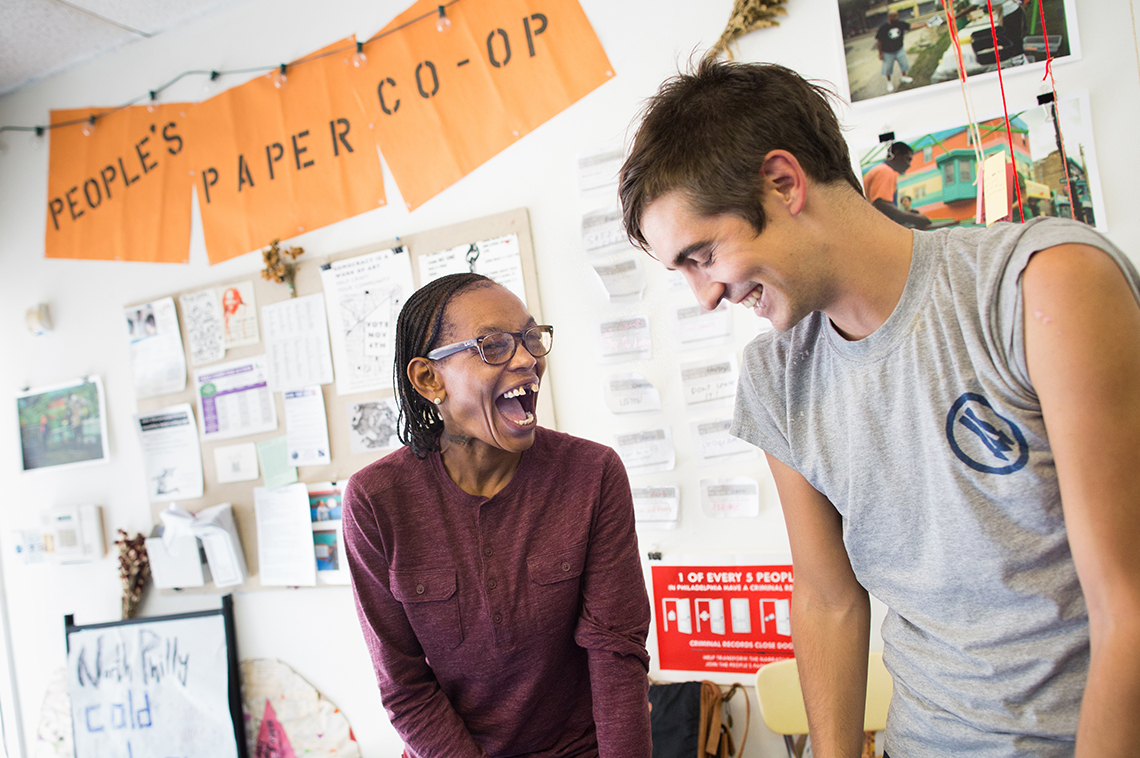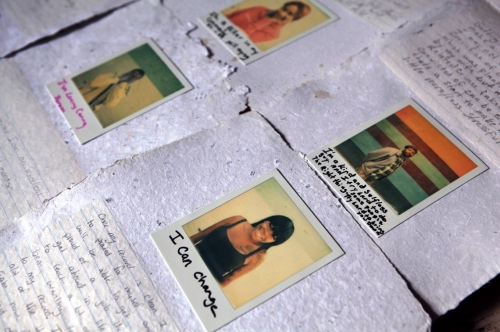
Those who have been following ArtPlace’s progress closely know that we talk about our work as investing in arts-based strategies to help achieve place-based outcomes in order to reposition arts and culture as a core sector of community planning and development. In order to make sure that we are covering the entire field of community planning and development, we have identified ten sectors that generally cover that terrain.
At our annual Grantee Summit that we hosted in Philadelphia in May, we organized our breakout sessions around these ten sectors, featuring our grantees working in those areas in conversation with an expert from the field. This post is the fifth in a ten-part series continuing those conversations, and it focuses on Public Safety.
Below is a summary of conversations we had with Enrique Betancourt (Director of the Violence and Crime Prevention Initiative for Chemonics International in Washington, DC), Devinder Culver (Community Projects Coordinator for the Greenville Police Department in Greenville, NC), Roger Cummings (Artistic Director of Juxtaposition Arts in Minneapolis, MN), and Mark Strandquist and Courtney Bowles (Artists-in-Residence with the Village of Arts and Humanities in Philadelphia, PA).
"A healthy community is a safe community," says Ronald Davis, the Director of the Office of Community Oriented Policing (COPS) of the US Department of Justice. "The greatest deterrent to crime and violence is not a community saturated with cops, it is a neighborhood alive with residents." This quote was recounted to us by Devinder Culver, the Community Projects Coordinator for the Greenville Police Department in Greenville, NC. Before the term creative placemaking existed, Greenville Police Department and Devinder were among the vanguard devising and shepherding arts-based interventions to both protect a community's citizenry and improve its quality of life. Their efforts over a decade may have helped distinguish Greenville as one of the nation's "100 Best communities for Young People" and contributed to Pitt County being one of the fastest growing regions in the state.
 Vibrant communities are, among other things, places where "people feel free of threats to their persons and property"—which is part of the descriptive definition of public safety adopted by the American Probation and Parole Association and the Manhattan Institute. But public safety is more than the mere presence of a robust police force and responsive emergency management infrastructure. For Devinder, "the work of policing—and law enforcement in general—has evolved to the point where progressive departments are not just enforcing the laws but include in their mandate crime prevention, intervention programs, suppression, and reintegration." Her framework exemplifies the holistic philosophy of our Community Development Matrix, and offers an instructive template for discussing how arts and culture can inform (and impact) this particular sector.
Vibrant communities are, among other things, places where "people feel free of threats to their persons and property"—which is part of the descriptive definition of public safety adopted by the American Probation and Parole Association and the Manhattan Institute. But public safety is more than the mere presence of a robust police force and responsive emergency management infrastructure. For Devinder, "the work of policing—and law enforcement in general—has evolved to the point where progressive departments are not just enforcing the laws but include in their mandate crime prevention, intervention programs, suppression, and reintegration." Her framework exemplifies the holistic philosophy of our Community Development Matrix, and offers an instructive template for discussing how arts and culture can inform (and impact) this particular sector.
Many pioneering community activists deploy arts and culture programs as preventative strategies, especially where youth are concerned. Roger Cummings, founder and artistic director of the nonprofit organization Juxtaposition Arts (JXTA), has made it his life’s work to “engage and employ” young urban artists in North Minneapolis, “in hands-on education initiatives that create pathways to self-sufficiency while actualizing their creative power.” JXTA’s model of ‘tactical urbanism’ follows the tenets of William Whyte in its emphasis on direct observation and engagement before program design. This approach has informed many successful initiatives, including short-term kiosks providing cheap food (like nachos and ramen), workshops where youth could play games or gain job skills, and opportunities for teens to share their own stories. Roger also discovered that micro-interventions like blowing bubbles after bars’ last call can significantly reduce aggressive behavior within his community.
 Arts programs also have strong efficacy as an intervention for repeat offenders—and, as evidenced by Roger’s work in Minneapolis, they’re particularly successful when they target at-risk youth. Devinder's work on "Project Success"—developed with representatives from The Department of Public Safety, Division of Adult Correction and Juvenile Justice, and Pitt County Schools—is a telling case-in-point. The project uses arts programs, primarily drawing and photography, to engage high school students on probation over a six-week period. The curriculum covered various scenarios with an emphasis on de-escalation. Its goal was to prevent recidivism and put the students on a path to graduation. The Greenville Police Department and Devinder hired a Project Success Coordinator within the school system who helped with implementation and data collection. Historically, 50% of students successfully completed probation, and Project Success increased this to 77%.
Arts programs also have strong efficacy as an intervention for repeat offenders—and, as evidenced by Roger’s work in Minneapolis, they’re particularly successful when they target at-risk youth. Devinder's work on "Project Success"—developed with representatives from The Department of Public Safety, Division of Adult Correction and Juvenile Justice, and Pitt County Schools—is a telling case-in-point. The project uses arts programs, primarily drawing and photography, to engage high school students on probation over a six-week period. The curriculum covered various scenarios with an emphasis on de-escalation. Its goal was to prevent recidivism and put the students on a path to graduation. The Greenville Police Department and Devinder hired a Project Success Coordinator within the school system who helped with implementation and data collection. Historically, 50% of students successfully completed probation, and Project Success increased this to 77%.
Suppression is the realm of law enforcement that is most familiar to the public, and involves agencies taking direct action to apprehend and isolate threats to public safety. The arts can help within this realm as well, particularly where community engagement and reconnaissance are concerned. Enrique Betancourt, an architect by training and former Executive Director of Mexico’s National Center for Crime Prevention, states that, “you will find two kinds of people working in communities that even the police fear to enter: artists and the church.” The fact that arts and culture assets exist in every community can be helpful when attempting to suppress crime. Enrique led an effort to decrease the homicide rate in Ciudad Juarez, a city along the U.S.-Mexican border that, as of 2009, had the highest reported murder rate in the world. Speaking about an initiative where local artists spearheaded a community mapping project, he elaborates, “it is in-part thanks to artists that we were able to tap into Juarez’s community networks and pinpoint the primary drivers of illicit activity.” According to the late Marvin Wolfgang, 5% of of a birth cohort is typically responsible for 50% of the crime. By leveraging the arts to identify the major sources of local crime, Enrique and his team were able to reduce Ciudad Juarez’s murder rate by 57% in 2012.
 Finally, forward-thinking practitioners must account for re-integrating formerly incarcerated individuals back into their communities, especially since—as Mark Strandquist and Courtney Bowles point out—"there are more people in the US with criminal records than the entire population of France." Mark and Courtney are Artists-in-Residence with the Village of Arts and Humanities and co-founders of The People's Paper Co-Op (PPC), an initiative that works with the formerly incarcerated to "co-design and co-facilitate community engagement pieces". Though the initiative encompasses everything from 'ladies night' socials to leadership workshops, the crux of the program is a (free) legal clinic wherein the participants receive expungement assistance and symbolically transform their criminal records into 'paper quilts' for legislative advocacy. This combines practical legal services from Philadelphia Lawyers for Social Equity with a powerful, cathartic experience: individuals literally pulping their criminal history and "rewriting their future." And beyond the empowering, therapeutic effects for the participants, Mark and Courtney have found that these events "become a rare staging ground for communities to discuss systemic issues, identify solutions, receive services, share their stories, and connect with others."
Finally, forward-thinking practitioners must account for re-integrating formerly incarcerated individuals back into their communities, especially since—as Mark Strandquist and Courtney Bowles point out—"there are more people in the US with criminal records than the entire population of France." Mark and Courtney are Artists-in-Residence with the Village of Arts and Humanities and co-founders of The People's Paper Co-Op (PPC), an initiative that works with the formerly incarcerated to "co-design and co-facilitate community engagement pieces". Though the initiative encompasses everything from 'ladies night' socials to leadership workshops, the crux of the program is a (free) legal clinic wherein the participants receive expungement assistance and symbolically transform their criminal records into 'paper quilts' for legislative advocacy. This combines practical legal services from Philadelphia Lawyers for Social Equity with a powerful, cathartic experience: individuals literally pulping their criminal history and "rewriting their future." And beyond the empowering, therapeutic effects for the participants, Mark and Courtney have found that these events "become a rare staging ground for communities to discuss systemic issues, identify solutions, receive services, share their stories, and connect with others."
As Devinder emphasizes, at a minimum, public safety includes law enforcement and emergency services, and it should also incorporate every sector’s approaches to crime—including arts and culture. We look forward to further investigating public safety as our third Field Scan this Fall, especially given its topical nature at the moment and the broad framing that leaders like Devinder utilize within their work.
Are there any other project examples that come to mind for you? Vexing challenges to be aware of? Let us know via the comments section below.





